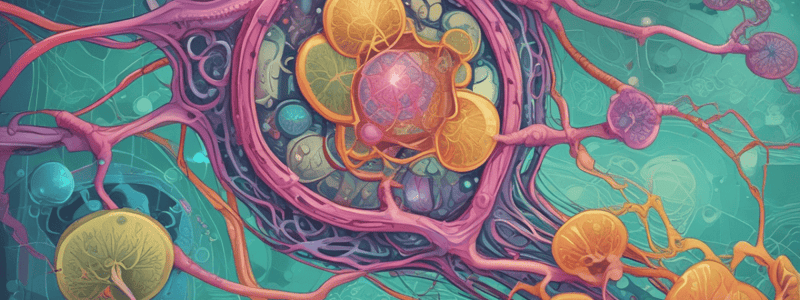Podcast
Questions and Answers
What is the basic structural and functional unit of all forms of life?
What is the basic structural and functional unit of all forms of life?
- Organ
- Organism
- Tissue
- Cell (correct)
Which type of cells have a nuclear membrane?
Which type of cells have a nuclear membrane?
- Eukaryotic cells (correct)
- Bacterial cells
- Prokaryotic cells
- Fungal cells
What processes do cells use to move large materials into or out of the cell?
What processes do cells use to move large materials into or out of the cell?
- Diffusion and osmosis
- Active transport and passive transport
- Endocytosis and exocytosis (correct)
- Phagocytosis and pinocytosis
Inclusions in a cell are primarily composed of what type of substances?
Inclusions in a cell are primarily composed of what type of substances?
Which organelle is involved in the process of cell division?
Which organelle is involved in the process of cell division?
What is the primary composition of the cell membrane?
What is the primary composition of the cell membrane?
What type of materials can inclusions release for energy?
What type of materials can inclusions release for energy?
Which of the following is NOT a structure found in eukaryotic cells?
Which of the following is NOT a structure found in eukaryotic cells?
Flashcards are hidden until you start studying
Study Notes
Cell Definition and Structure
- The cell is the basic structural and functional unit of all forms of life.
- Every cell consists of cytoplasm enclosed within a membrane and contains various organelles, including:
- Nucleus
- Endoplasmic reticulum
- Golgi apparatus
- Cytoskeleton
- Ribosome
- Centrosomes
Cell Classification
- Cells are classified into two main types based on the presence of a nuclear membrane: Eukaryotic and Prokaryotic cells.
Cell Membrane
- The cell membrane is a double layer of phospholipids, which are amphiphilic (partly hydrophobic and partly hydrophilic).
- The cell membrane has two main functions:
- Regulating the movement of materials into and out of the cell through endocytosis and exocytosis.
- Allowing large molecules, microorganisms, and waste products to pass through.
Inclusions
- Inclusions are metabolically inert substances that are stored in the cell and released as needed.
- Examples of inclusions include:
- Masses of organic chemicals
- Lipids
- Glycogen
- Melanin (stored in skin and oral mucosa cells and responsible for pigmentation)
- Residual bodies (spent lysosomes and their digested material)
Cell Division (Mitosis)
- Mitosis is a complex process involving many organelles of the cell.
- Mitosis occurs during tissue growth or regeneration and is dependent on the length of the individual cell's lifespan.
Studying That Suits You
Use AI to generate personalized quizzes and flashcards to suit your learning preferences.




